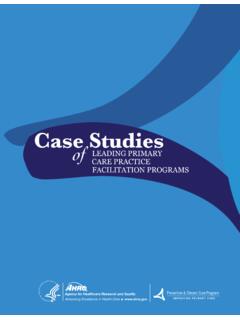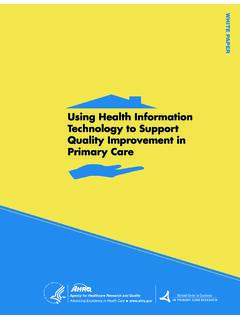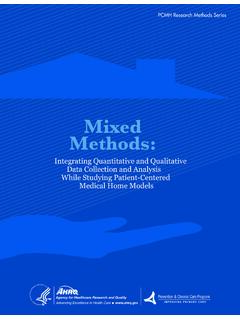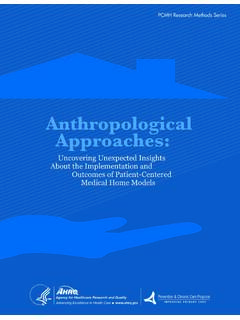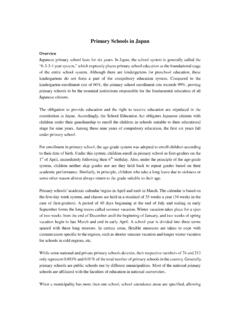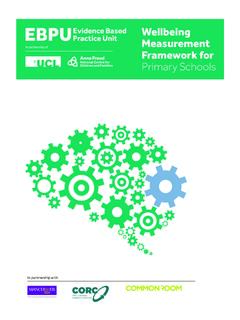Transcription of Developing and Running a Primary Care Practice ...
1 Developing and Running a Primary Care Practice facilitation Program: A How-to GuideAgency for Healthcare Research and QualityAdvancing Excellence in Health Care is the lead Federal agency charged with supporting research designed to improve the quality of health care, reduce its cost, address patient safety and medical errors, and broaden access to essential services. AHQR sponsors and conducts research that provides evidence-based information on health care outcomes; quality; and cost, use, and access. The information helps health care decisionmakers patients and clinicians, health system leaders, and policymakers make more informed decisions and improve the quality of health care services. Developing and Running a Primary Care Practice facilitation Program: A How-to Guide Agency for Healthcare Research and Quality 540 Gaither Road Rockville, MD 20850 Authors: Lyndee Knox, LA Net Erin Fries Taylor, Mathematica Policy Research Kristin Geonnotti, Mathematica Policy Research Rachel Machta, Mathematica Policy Research Jung Kim, Mathematica Policy Research Jessica Nysenbaum, Mathematica Policy Research Michael Parchman, Agency for Healthcare Research & Quality AHRQ Publication No.
2 12-0011 December 2011 This report is based on research conducted by Mathematica Policy Research under contract with the Agency for Healthcare Research and Quality (AHRQ), Rockville, MD, Department of Health and Human Services (Contract No. HHSA290200900019I). The findings and conclusions in this document are those of the author(s), who are responsible for its content and do not necessarily represent the views of AHRQ. No statement in this report should be construed as an official position of AHRQ or of the Department of Health and Human Services. This document is in the public domain and may be used and reprinted without permission except those copyrighted materials that are clearly noted in the document. Further reproduction of those copyrighted materials is prohibited without the specific permission of copyright holders. Suggested Citation: Knox L, Taylor EF, Geonnotti K, Machta R, Kim J, Nysenbaum J, Parchman, M.
3 Developing and Running a Primary Care Practice facilitation Program: A How-to Guide (Prepared by Mathematica Policy Research under Contract No. HHSA290200900019I TO 5.) AHRQ Publication No. 12-0011. Rockville, MD: Agency for Healthcare Research and Quality. December 2011. Acknowledgments This guide was a collaborative effort of many individuals. The Agency for Healthcare Research and Quality (AHRQ), in coordination with Lyndee Knox of LA Net (who served as the facilitator) and Mathematica Policy Research, convened an expert working group (listed below) to develop the guide. Through a series of telephone meetings, group members provided information and insights from their own experiences in Developing and Running PF programs and shared numerous tools and resources. The willingness of working group members to share their expertise and lend their time was critical to the development of this guide.
4 Our colleagues at AHRQ including Drs. David Meyers and Janice Genevro provided valuable direction, guidance, and feedback throughout this guide s development. We are grateful to those who reviewed the manual and provided thoughtful comments and suggestions, including: Sajid Ahmed, HITEC-LA; Chet Fox, , Upstate New York Practice Based Research Network; Vanesscia John, , , California Primary Care Association; Vanessa Nguyen, , LA Net; Richard Seidman, , Care Health Plan; Martin Serota, , AltaMed Health Services; Kimbra Wells Metz, , Washington Academy of Family Physicians; and Diana Traje, LA Net. Marsha Gold and Eugene Rich at Mathematica provided a thoughtful peer review, Molly and Jim Cameron provided superb editing, and Felita Buckner offered excellent secretarial support. Debbie Peikes supplied valuable high-level guidance in her role as director of the large set of tasks under which this work was supported.
5 Iii Page is intentionally left blank to allow for double side copying Contributors Carolyn Allshouse, Family Voices of Minnesota Cheryl Aspy, , University of Oklahoma Health Sciences Center Thomas Bodenheimer, , , San Francisco General Hospital Bonni Brownlee, , Qualis Health Caroline Carter, , L . , Center for Health Care Research & Policy, MetroHealth Medical Center Katie Coleman, , Group Health Cooperative Allen Dietrich, , Dartmouth Medical School Darren A. DeWalt, , , University of North Carolina School of Medicine Perry Dickinson, , University of Colorado Elizabeth Foley, , Medical Care Development Brenda Fraser, , Quality Improvement and Innovation Partnership Allyson Gottsman, Health TeamWorks Joanne Gutowsky, Michigan Primary Care Consortium (MPCC) William Hogg, , Department of Family Medicine, University of Ottawa Craig Jones, , Vermont Blueprint for Health Ann Lefebvre, , CPHQ, NC AHEC Program at University of North Carolina at Chapel Hill Clare Liddy, , Department of Family Medicine, University of Ottawa Jeanne McAllister, , , , Center for Medical Home Improvement Marly McMillen, , The Dochterman Group Gail McNutt, , Department of Veterans Affairs James Mold, , University of Oklahoma College of Medicine Regina Neal, Primary Care Development Corporation Amanda Parsons, , , New York City Department of Health & Mental Hygiene Joan Pernice, , , Massachusetts League of Community Health Centers Diane Powers.
6 , University of Washington Mary Ruhe, , , Case Western Reserve University Constance S. Sixta, , , , Sixta Consulting Inc. Jenney Samuelson, Vermont Blueprint for Health Lisa Watkins, Vermont Blueprint for Health v Page is intentionally left blank to allow for double side copying Preface If we truly believe that Primary care is too important to fail, how will we ensure its success? This is the question that motivated the development of this how-to guide. The delivery of Primary care is complex, to say the least. Changing a complex system like a Primary care Practice is fraught with difficulties and challenges, leading to the common analogy of redesigning an airplane while it s flying. One of the most promising methods to support Primary care transformation is a Practice facilitation model that supports an ongoing, trusting relationship between an external facilitator and a Primary care Practice .
7 This is not the traditional parachute in model of facilitation often seen in the corporate world. Although some of the basic facilitation skills may be similar, this model is much more aligned with the Federal Government s agricultural cooperative extension system developed in the early 20th This manual draws on the collective experience and knowledge of a remarkable group of people who have been involved in Practice facilitation for many years. As a participant on many of the calls conducted in preparing this work, I found their commitment to the writing of this manual inspirational. We here at AHRQ express our heartfelt appreciation for their invaluable contributions. Our thanks to this team for taking on and completing this extremely challenging task. It is our hope that this manual will be a starting point for many successful Practice facilitation programs, and that the delivery of Primary care in the United States truly will be transformed as a result.
8 Century. The intent of this manual is not to describe how to facilitate change in a Primary care Practice ; rather, its focus is on how to establish and run an effective Practice facilitation program. Its intended audience is organizations or individuals who will develop and run such a program. Michael L. Parchman, , PBRN Initiative Director & Senior Advisor for Primary Care Center for Primary Care, Prevention, and Clinical Partnerships Agency for Healthcare Research and Quality vii Page is intentionally left blank to allow for double side copying About This Guide The contents of this guide were developed from the suggestions and experiences of a panel of more than 30 individuals recognized by their peers as possessing expertise in the design and management of Practice facilitation programs for Primary care transformation. Unless otherwise noted, the experts referred to throughout the guide are the contributors listed on the title page who served as members of the working group.
9 While the contributors included many prominent experts representing a wide range of organizations, we recognize that other Practice facilitation experts and organizations exist whose views are not necessarily reflected here. This guide reflects current practical knowledge and hard-won lessons from the area of Practice facilitation . Its aim is to provide information for others to draw on, but should not be taken as a final statement on how to develop facilitation programs. This work is intended to assist others so they do not have to reinvent the wheel, while recognizing that other, more refined approaches and techniques may evolve over time particularly as facilitation programs focus increasingly on transformational efforts in Primary care Practice . ix Page is intentionally left blank to allow for double side copying xi Overview Why Was This Guide Developed?
10 This how-to guide was developed by the Agency for Healthcare Research and Quality to support organizations interested in starting a Practice facilitation (PF) program for Primary care transformation. The focus on Primary care transformation reflects the growing consensus that the Primary care system must be redesigned in fundamental ways so that, in the end, we improve health and patient experience and lower costs. In this guide, we define PF as a supportive service provided to a Primary care Practice by a trained individual or team, using a range of quality improvement (QI) and Practice improvement approaches to build the internal capacity of a Practice to improve over time. Another aim of PF is to support attainment of both incremental and transformative QI goals, with the ultimate goal of improving patient outcomes. What Are the Goals of This Guide?
